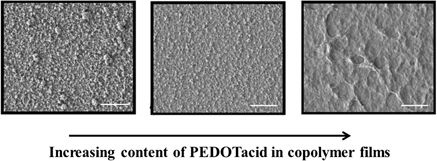Crossref Citations
This article has been cited by the following publications. This list is generated based on data provided by
Crossref.
Wei, Bin
Liu, Jinglin
Ouyang, Liangqi
Kuo, Chin-Chen
and
Martin, David C.
2015.
Significant Enhancement of PEDOT Thin Film Adhesion to Inorganic Solid Substrates with EDOT-Acid.
ACS Applied Materials & Interfaces,
Vol. 7,
Issue. 28,
p.
15388.
O'Connor, Timothy F.
Rajan, Kirtana M.
Printz, Adam D.
and
Lipomi, Darren J.
2015.
Toward organic electronics with properties inspired by biological tissue.
Journal of Materials Chemistry B,
Vol. 3,
Issue. 25,
p.
4947.
Martin, David C.
2015.
Molecular design, synthesis, and characterization of conjugated polymers for interfacing electronic biomedical devices with living tissue.
MRS Communications,
Vol. 5,
Issue. 2,
p.
131.
Bhagwat, Nandita
Murray, Roy E.
Shah, S. Ismat
Kiick, Kristi L.
and
Martin, David C.
2016.
Biofunctionalization of PEDOT films with laminin-derived peptides.
Acta Biomaterialia,
Vol. 41,
Issue. ,
p.
235.
Strakosas, Xenofon
Wei, Bin
Martin, David C.
and
Owens, Roisin M.
2016.
Biofunctionalization of polydioxythiophene derivatives for biomedical applications.
Journal of Materials Chemistry B,
Vol. 4,
Issue. 29,
p.
4952.
Woeppel, Kevin
Yang, Qianru
and
Cui, Xinyan Tracy
2017.
Recent advances in neural electrode–tissue interfaces.
Current Opinion in Biomedical Engineering,
Vol. 4,
Issue. ,
p.
21.
Povlich, L.K.
Feldman, K.E.
Wei, B.
Eom, T.
Shim, B.S.
and
Martin, D.C.
2017.
Comprehensive Biomaterials II.
p.
664.
Root, Samuel E.
Savagatrup, Suchol
Printz, Adam D.
Rodriquez, Daniel
and
Lipomi, Darren J.
2017.
Mechanical Properties of Organic Semiconductors for Stretchable, Highly Flexible, and Mechanically Robust Electronics.
Chemical Reviews,
Vol. 117,
Issue. 9,
p.
6467.
Chen, Nuan
Tian, Lingling
Patil, Anoop C.
Peng, Shengjie
Yang, In Hong
Thakor, Nitish V.
and
Ramakrishna, Seeram
2017.
Neural interfaces engineered via micro- and nanostructured coatings.
Nano Today,
Vol. 14,
Issue. ,
p.
59.
Stassi, Stefano
Fantino, Erika
Calmo, Roberta
Chiappone, Annalisa
Gillono, Matteo
Scaiola, Davide
Pirri, Candido Fabrizio
Ricciardi, Carlo
Chiadò, Alessandro
and
Roppolo, Ignazio
2017.
Polymeric 3D Printed Functional Microcantilevers for Biosensing Applications.
ACS Applied Materials & Interfaces,
Vol. 9,
Issue. 22,
p.
19193.
Inal, Sahika
Hama, Adel
Ferro, Magali
Pitsalidis, Charalampos
Oziat, Julie
Iandolo, Donata
Pappa, Anna‐Maria
Hadida, Mikhael
Huerta, Miriam
Marchat, David
Mailley, Pascal
and
Owens, Róisín M.
2017.
Conducting Polymer Scaffolds for Hosting and Monitoring 3D Cell Culture.
Advanced Biosystems,
Vol. 1,
Issue. 6,
Murbach, Jamie M.
Currlin, Seth
Widener, Adrienne
Tong, Yuxin
Chhatre, Shrirang
Subramanian, Vivek
Martin, David C.
Johnson, Blake N.
and
Otto, Kevin J.
2018.
In situ electrochemical polymerization of poly(3,4-ethylenedioxythiophene) (PEDOT) for peripheral nerve interfaces.
MRS Communications,
Vol. 8,
Issue. 3,
p.
1043.
Sanchez-Sanchez, Ana
del Agua, Isabel
Malliaras, George G.
and
Mecerreyes, David
2019.
Smart Polymers and their Applications.
p.
191.
Subramanian, Vivek
Rowland, Casey A.
Yap, Glenn P. A.
and
Martin, David C.
2019.
Morphology, Molecular Orientation, and Solid-State Characterization of 2,3-Dihydrothieno[3,4-b][1,4]dioxine-2-carboxylic Acid (EDOTacid).
Crystal Growth & Design,
Vol. 19,
Issue. 11,
p.
6184.
Ohayon, David
and
Inal, Sahika
2020.
Organic Bioelectronics: From Functional Materials to Next‐Generation Devices and Power Sources.
Advanced Materials,
Vol. 32,
Issue. 36,
Nagane, Samadhan
Sitarik, Peter
Wu, Yuhang
Baugh, Quintin
Chhatre, Shrirang
Lee, Junghyun
and
Martin, David C.
2020.
Functionalized Polythiophene Copolymers for Electronic Biomedical Devices.
MRS Advances,
Vol. 5,
Issue. 18-19,
p.
943.
Moghimiardekani, Ali
Molina, Brenda G.
Enshaei, Hamidreza
del Valle, Luis J.
Pérez‐Madrigal, Maria M.
Estrany, Francesc
and
Alemán, Carlos
2020.
Semi‐Interpenetrated Hydrogels‐Microfibers Electroactive Assemblies for Release and Real‐Time Monitoring of Drugs.
Macromolecular Bioscience,
Vol. 20,
Issue. 7,
Fenoy, Gonzalo E.
Azzaroni, Omar
Knoll, Wolfgang
and
Marmisollé, Waldemar A.
2021.
Functionalization Strategies of PEDOT and PEDOT:PSS Films for Organic Bioelectronics Applications.
Chemosensors,
Vol. 9,
Issue. 8,
p.
212.
Marek, T.
Orbán, G.
Meszéna, D.
Márton, G.
Ulbert, I.
Mészáros, G.
and
Keresztes, Z.
2021.
Optimization aspects of electrodeposition of photoluminescent conductive polymer layer onto neural microelectrode arrays.
Materials Chemistry and Physics,
Vol. 260,
Issue. ,
p.
124163.
Subramanian, Vivek
and
Martin, David C.
2021.
Direct Observation of Liquid-to-Solid Phase Transformations during the Electrochemical Deposition of Poly(3,4-ethylenedioxythiophene) (PEDOT) by Liquid-Phase Transmission Electron Microscopy (LPTEM).
Macromolecules,
Vol. 54,
Issue. 14,
p.
6956.
